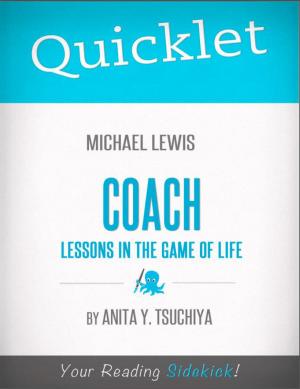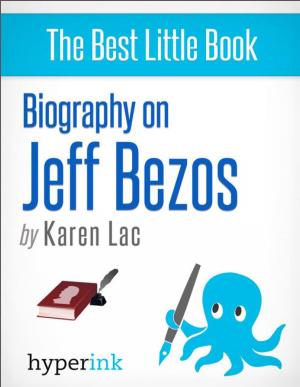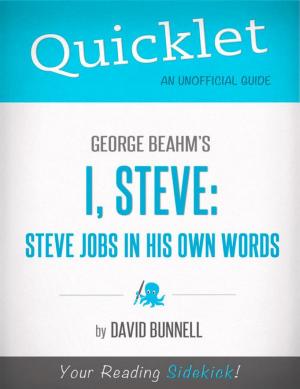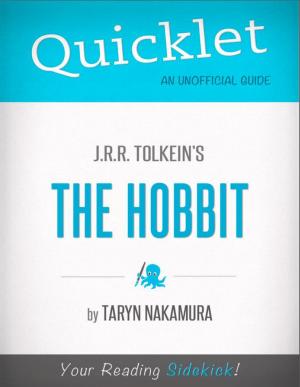Quicklet on The Best Ramones Songs: Lyrics and Analysis
Nonfiction, Reference & Language, Study Aids, Book Notes, Fiction & Literature, Literary Theory & Criticism| Author: | David Cassel | ISBN: | 9781614646310 |
| Publisher: | Hyperink | Publication: | July 30, 2012 |
| Imprint: | Hyperink | Language: | English |
| Author: | David Cassel |
| ISBN: | 9781614646310 |
| Publisher: | Hyperink |
| Publication: | July 30, 2012 |
| Imprint: | Hyperink |
| Language: | English |
ABOUT THE BOOK
Via Sugar Sweet Sunshine
It's like the world is still quivering from that night they took the stage in New York City — counting out just a little too fast, “1, 2, 3, 4...” When the four Ramones first played “Blitzkrieg Bop” in 1974, they were raw, ragged, and revolutionary. They played a new kind of rock that was more intense —darker, faster, funnier, and more free. It was Dee Dee, Tommy, Johnny, and Joey Ramone who were the first to imagine a world where the music sounded so different.
Over the years we realized their band was resurrecting those taboo rock joys they'd first experienced as young teenagers, when radio rock was a freak-welcoming place, and everyone could share a wild abandonment together. In trying to reclaim that power — the dark magic they remembered — the Ramones spewed out their own pumped-up mystery, distilled from comic-book horrors, the evils both in the world around us and from their own lives, and, most of all, that powerful early fascination with what rock had meant to them and their refusal to forget what rock could mean...
I actually met the Ramones just a few years after they launched, at one of their personal appearances in California. They’d already burned through two drummers, and the four tough-looking musicians were all lined up behind a table at a record store, staring back dangerously. Awed by their reputation, all I could think to ask was, “What's it like being a Ramone?” “It's very rewarding,” replied their new drummer Richie, adding “I recommend it” — a semi-sarcastic answer that was part put-on, part mystique. It was just like the way every musician who played in the band took the last name “Ramone,” even though none of them were in any way related. Though they cultivated this mock mysteriousness, the best thing about the Ramones was ultimately their kids-from-the-neighborhood attitude, their daring to believe in the idea that you could be famous without changing.
In so doing, they changed the relationship between performers and audiences forever, smashing their guitars against that big wall between the media and the rest of us. Their songs catch the tension between pop music and raw reality, that love-hate dance between fame and grit, or the stage and the street, with one very radical idea: that real was enough. One of the surprises of their career is that they lived many of the cartoon horrors they described, that their life was as startling as their music. Their songs actually capture pieces of their life — that's part of what makes the songs feel so real — and they left them behind as part of a legend which can still haunt the musicians of today.
In the end, it was almost as though a cruel universe felt it had to hunt down the Ramones and kill them. The voice behind the Ramones was their lovably ordinary vocalist Joey Ramone, who died of cancer in 2001 at the age of 49. And just thirteen months later, the man who’d laid down the relentless bass lines on their first albums, Dee Dee Ramone, died of a heroin overdose at the age of 50. By 2004, cancer had also claimed their fierce guitarist Johnny Ramone at the age of 55. The only original band member to even reach the age of 60 was drummer Tommy, who also co-produced their first albums (and continues producing music to this day).
Though the line-up of the band sometimes changed, the Ramones' sound was always a reaction to the decline of rock in the 1970s...and an attempt to shove it in a new direction. But there was also always a tension between darkness and light — a mad hope that these wild real-life stories could somehow ascend into pop music heaven. It was a 20-year war that created love, death, and heroes, while slowly attracting believers and eventually a movement.
ABOUT THE BOOK
Via Sugar Sweet Sunshine
It's like the world is still quivering from that night they took the stage in New York City — counting out just a little too fast, “1, 2, 3, 4...” When the four Ramones first played “Blitzkrieg Bop” in 1974, they were raw, ragged, and revolutionary. They played a new kind of rock that was more intense —darker, faster, funnier, and more free. It was Dee Dee, Tommy, Johnny, and Joey Ramone who were the first to imagine a world where the music sounded so different.
Over the years we realized their band was resurrecting those taboo rock joys they'd first experienced as young teenagers, when radio rock was a freak-welcoming place, and everyone could share a wild abandonment together. In trying to reclaim that power — the dark magic they remembered — the Ramones spewed out their own pumped-up mystery, distilled from comic-book horrors, the evils both in the world around us and from their own lives, and, most of all, that powerful early fascination with what rock had meant to them and their refusal to forget what rock could mean...
I actually met the Ramones just a few years after they launched, at one of their personal appearances in California. They’d already burned through two drummers, and the four tough-looking musicians were all lined up behind a table at a record store, staring back dangerously. Awed by their reputation, all I could think to ask was, “What's it like being a Ramone?” “It's very rewarding,” replied their new drummer Richie, adding “I recommend it” — a semi-sarcastic answer that was part put-on, part mystique. It was just like the way every musician who played in the band took the last name “Ramone,” even though none of them were in any way related. Though they cultivated this mock mysteriousness, the best thing about the Ramones was ultimately their kids-from-the-neighborhood attitude, their daring to believe in the idea that you could be famous without changing.
In so doing, they changed the relationship between performers and audiences forever, smashing their guitars against that big wall between the media and the rest of us. Their songs catch the tension between pop music and raw reality, that love-hate dance between fame and grit, or the stage and the street, with one very radical idea: that real was enough. One of the surprises of their career is that they lived many of the cartoon horrors they described, that their life was as startling as their music. Their songs actually capture pieces of their life — that's part of what makes the songs feel so real — and they left them behind as part of a legend which can still haunt the musicians of today.
In the end, it was almost as though a cruel universe felt it had to hunt down the Ramones and kill them. The voice behind the Ramones was their lovably ordinary vocalist Joey Ramone, who died of cancer in 2001 at the age of 49. And just thirteen months later, the man who’d laid down the relentless bass lines on their first albums, Dee Dee Ramone, died of a heroin overdose at the age of 50. By 2004, cancer had also claimed their fierce guitarist Johnny Ramone at the age of 55. The only original band member to even reach the age of 60 was drummer Tommy, who also co-produced their first albums (and continues producing music to this day).
Though the line-up of the band sometimes changed, the Ramones' sound was always a reaction to the decline of rock in the 1970s...and an attempt to shove it in a new direction. But there was also always a tension between darkness and light — a mad hope that these wild real-life stories could somehow ascend into pop music heaven. It was a 20-year war that created love, death, and heroes, while slowly attracting believers and eventually a movement.















